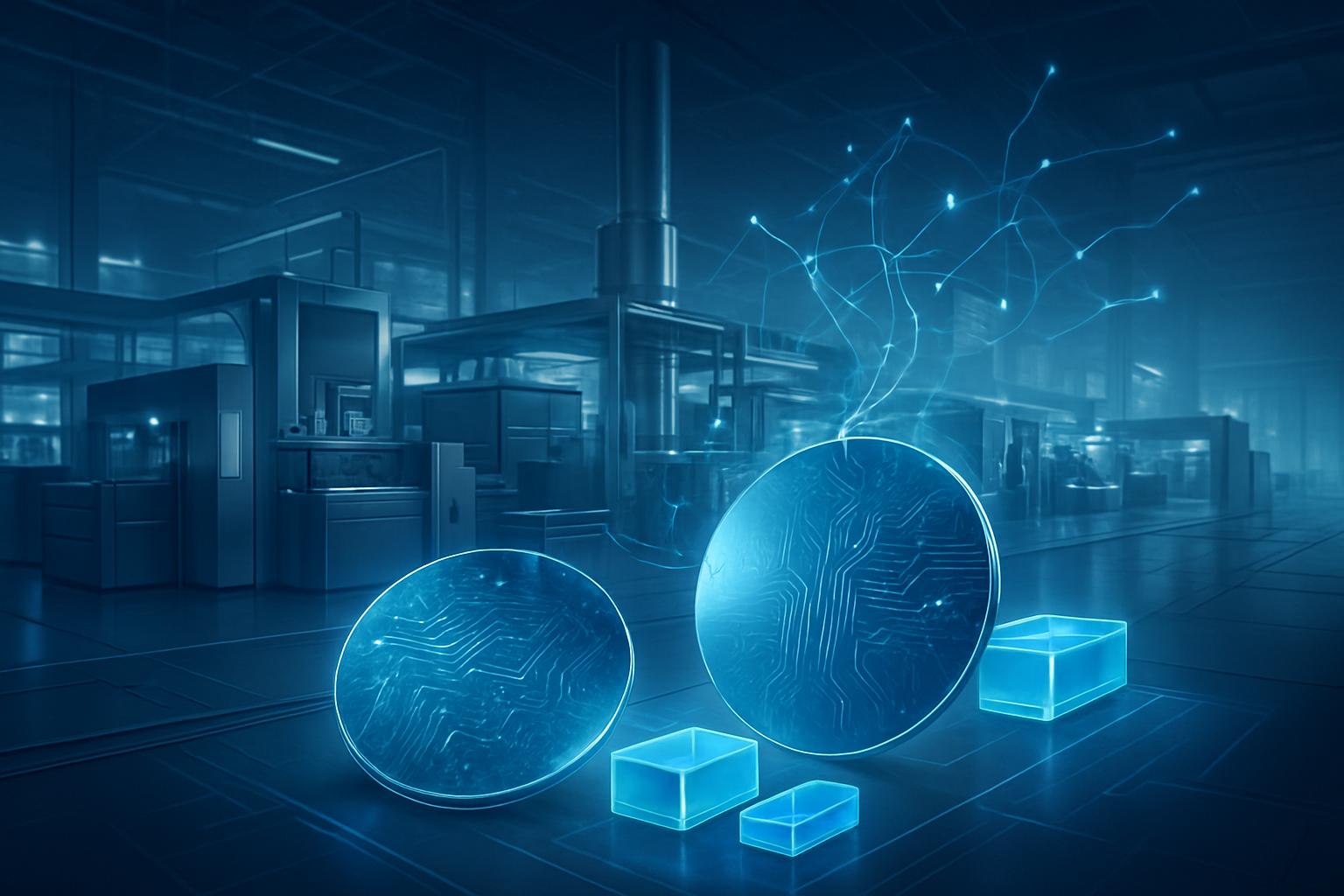The global semiconductor industry, a linchpin of modern technology and national power, is increasingly at the epicenter of a complex geopolitical struggle. Recent policy shifts by the United States, particularly the authorization of advanced American semiconductor exports to companies in Saudi Arabia and the United Arab Emirates (UAE), signal a significant recalibration of Washington's strategy in the high-stakes race for technological supremacy. This move, coming amidst an era of stringent export controls primarily aimed at curbing China's technological ambitions, carries profound implications for the global semiconductor supply chain, international relations, and the future trajectory of AI development.
This strategic pivot reflects a multifaceted approach by the U.S. to balance national security interests with commercial opportunities and diplomatic alliances. By greenlighting the sale of cutting-edge chips to key Middle Eastern partners, the U.S. aims to cement its technological leadership in emerging markets, diversify demand for American semiconductor firms, and foster stronger bilateral ties, even as it navigates concerns about potential technology leakage to rival nations. The immediate significance of these developments lies in their potential to reshape market dynamics, create new regional AI powerhouses, and further entrench the semiconductor industry as a critical battleground for global influence.
Navigating the Labyrinth of Advanced Chip Controls: From Tiered Rules to Tailored Deals
The technical architecture of U.S. semiconductor export controls is a meticulously crafted, yet constantly evolving, framework designed to safeguard critical technologies. At its core, these regulations target advanced computing semiconductors, AI-capable chips, and high-bandwidth memory (HBM) that exceed specific performance thresholds and density parameters. The aim is to prevent the acquisition of chips that could fuel military modernization and sophisticated surveillance by nations deemed adversaries. This includes not only direct high-performance chips but also measures to prevent the aggregation of smaller, non-controlled integrated circuits (ICs) to achieve restricted processing power, alongside controls on crucial software keys.
Beyond the chips themselves, the controls extend to the highly specialized Semiconductor Manufacturing Equipment (SME) essential for producing advanced-node ICs, particularly logic chips under a 16-nanometer threshold. This encompasses a broad spectrum of tools, from physical vapor deposition equipment to Electronic Computer Aided Design (ECAD) and Technology Computer-Aided Design (TCAD) software. A pivotal element of these controls is the extraterritorial reach of the Foreign Direct Product Rule (FDPR), which subjects foreign-produced items to U.S. export controls if they are the direct product of certain U.S. technology, software, or equipment, effectively curbing circumvention efforts by limiting foreign manufacturers' ability to use U.S. inputs for restricted items.
A significant policy shift has recently redefined the approach to AI chip exports, particularly affecting countries like Saudi Arabia and the UAE. The Biden administration's proposed "Export Control Framework for Artificial Intelligence (AI) Diffusion," introduced in January 2025, envisioned a global tiered licensing regime. This framework categorized countries into three tiers: Tier 1 for close allies with broad exemptions, Tier 2 for over 100 countries (including Saudi Arabia and the UAE) subject to quotas and license requirements with a presumption of approval up to an allocation, and Tier 3 for nations facing complete restrictions. The objective was to ensure responsible AI diffusion while connecting it to U.S. national security.
However, this tiered framework was rescinded on May 13, 2025, by the Trump administration, just two days before its scheduled effective date. The rationale for the rescission cited concerns that the rule would stifle American innovation, impose burdensome regulations, and potentially undermine diplomatic relations by relegating many countries to a "second-tier status." In its place, the Trump administration has adopted a more flexible, deal-by-deal strategy, negotiating individual agreements for AI chip exports. This new approach has directly led to significant authorizations for Saudi Arabia and the UAE, with Saudi Arabia's Humain slated to receive hundreds of thousands of advanced Nvidia AI chips over five years, including GB300 Grace Blackwell products, and the UAE potentially receiving 500,000 advanced Nvidia chips annually from 2025 to 2027.
Initial reactions from the AI research community and industry experts have been mixed. The Biden-era "AI Diffusion Rule" faced "swift pushback from industry," including "stiff opposition from chip majors including Oracle and Nvidia," who argued it was "overdesigned, yet underinformed" and could have "potentially catastrophic consequences for U.S. digital industry leadership." Concerns were raised that restricting AI chip exports to much of the world would limit market opportunities and inadvertently empower foreign competitors. The rescission of this rule, therefore, brought a sense of relief and opportunity to many in the industry, with Nvidia hailing it as an "opportunity for the U.S. to lead the 'next industrial revolution.'" However, the shift to a deal-by-deal strategy, especially regarding increased access for Saudi Arabia and the UAE, has sparked controversy among some U.S. officials and experts, who question the reliability of these countries as allies and voice concerns about potential technology leakage to adversaries, underscoring the ongoing challenge of balancing security with open innovation.
Corporate Fortunes in the Geopolitical Crosshairs: Winners, Losers, and Strategic Shifts
The intricate web of geopolitical influences and export controls is fundamentally reshaping the competitive landscape for semiconductor companies, tech giants, and nascent startups alike. The recent U.S. authorizations for advanced American semiconductor exports to Saudi Arabia and the UAE have created distinct winners and losers, while forcing strategic recalculations across the industry.
Direct beneficiaries of these policy shifts are unequivocally U.S.-based advanced AI chip manufacturers such as NVIDIA (NASDAQ: NVDA) and Advanced Micro Devices (NASDAQ: AMD). With the U.S. Commerce Department greenlighting the export of the equivalent of up to 35,000 NVIDIA Blackwell chips (GB300s) to entities like G42 in the UAE and Humain in Saudi Arabia, these companies gain access to lucrative, large-scale markets in the Middle East. This influx of demand can help offset potential revenue losses from stringent restrictions in other regions, particularly China, providing significant revenue streams and opportunities to expand their global footprint in high-performance computing and AI infrastructure. For instance, Saudi Arabia's Humain is poised to acquire a substantial number of NVIDIA AI chips and collaborate with Elon Musk's xAI, while AMD has also secured a multi-billion dollar agreement with the Saudi venture.
Conversely, the broader landscape of export controls, especially those targeting China, continues to pose significant challenges. While new markets emerge, the overall restrictions can lead to substantial revenue reductions for American chipmakers and potentially curtail their investments in research and development (R&D). Moreover, these controls inadvertently incentivize China to accelerate its pursuit of semiconductor self-sufficiency, which could, in the long term, erode the market position of U.S. firms. Tech giants with extensive global operations, such as Microsoft (NASDAQ: MSFT), Google (NASDAQ: GOOGL), and Amazon (NASDAQ: AMZN), also stand to benefit from the expansion of AI infrastructure in the Gulf, as they are key players in cloud services and AI development. However, they simultaneously face increased regulatory scrutiny, compliance costs, and the complexity of navigating conflicting regulations across diverse jurisdictions, which can impact their global strategies.
For startups, especially those operating in advanced or dual-use technologies, the geopolitical climate presents a more precarious situation. Export controls can severely limit funding and acquisition opportunities, as national security reviews of foreign investments become more prevalent. Compliance with these regulations, including identifying restricted parties and sanctioned locations, adds a significant operational and financial burden, and unintentional violations can lead to costly penalties. Furthermore, the complexities extend to talent acquisition, as hiring foreign employees who may access sensitive technology can trigger export control regulations, potentially requiring specific licenses and complicating international team building. Sudden policy shifts, like the recent rescission of the "AI Diffusion Rules," can also catch startups off guard, disrupting carefully laid business strategies and supply chains.
In this dynamic environment, Valens Semiconductor Ltd. (NYSE: VLN), an Israeli fabless company specializing in high-performance connectivity chipsets for the automotive and audio-video (Pro-AV) industries, presents an interesting case study. Valens' core technologies, including HDBaseT for uncompressed multimedia distribution and MIPI A-PHY for high-speed in-vehicle connectivity in ADAS and autonomous driving, are foundational to reliable data transmission. Given its primary focus, the direct impact of the recent U.S. authorizations for advanced AI processing chips on Valens is likely minimal, as the company does not produce the high-end GPUs or AI accelerators that are the subject of these specific controls.
However, indirect implications and future opportunities for Valens Semiconductor cannot be overlooked. As Saudi Arabia and the UAE pour investments into building "sovereign AI" infrastructure, including vast data centers, there will be an increased demand for robust, high-performance connectivity solutions that extend beyond just the AI processors. If these regions expand their technological ambitions into smart cities, advanced automotive infrastructure, or sophisticated Pro-AV installations, Valens' expertise in high-bandwidth, long-reach, and EMI-resilient connectivity could become highly relevant. Their MIPI A-PHY standard, for instance, could be crucial if Gulf states develop advanced domestic automotive industries requiring sophisticated in-vehicle sensor connectivity. While not directly competing with AI chip manufacturers, the broader influx of U.S. technology into the Middle East could create an ecosystem that indirectly encourages other connectivity solution providers to target these regions, potentially increasing competition. Valens' established leadership in industry standards provides a strategic advantage, and if these standards gain traction in newly developing tech hubs, the company could capitalize on its foundational technology, further building long-term wealth for its investors.
A New Global Order: Semiconductors as the Currency of Power
The geopolitical influences and export controls currently gripping the semiconductor industry transcend mere economic concerns; they represent a fundamental reordering of global power dynamics, with advanced chips serving as the new currency of technological sovereignty. The recent U.S. authorizations for advanced American semiconductor exports to Saudi Arabia and the UAE are not isolated incidents but rather strategic maneuvers within this larger geopolitical chess game, carrying profound implications for the broader AI landscape, global supply chains, national security, and the delicate balance of international power.
This era marks a defining moment in technological history, where governments are increasingly wielding export controls as a potent tool to restrict the flow of critical technologies. The United States, for instance, has implemented stringent controls on semiconductor technology primarily to limit China's access, driven by concerns over its potential use for both economic and military growth under Beijing's "Military-Civil Fusion" strategy. This "small yard, high fence" approach aims to protect critical technologies while minimizing broader economic spillovers. The U.S. authorizations for Saudi Arabia and the UAE, specifically the export of NVIDIA's Blackwell chips, signify a strategic pivot to strengthen ties with key regional partners, drawing them into the U.S.-aligned technology ecosystem and countering Chinese technological influence in the Middle East. These deals, often accompanied by "security conditions" to exclude Chinese technology, aim to solidify American technological leadership in emerging AI hubs.
This strategic competition is profoundly impacting global supply chains. The highly concentrated nature of semiconductor manufacturing, with Taiwan, South Korea, and the Netherlands as major hubs, renders the supply chain exceptionally vulnerable to geopolitical tensions. Export controls restrict the availability of critical components and equipment, leading to supply shortages, increased costs, and compelling companies to diversify their sourcing and production locations. The COVID-19 pandemic already exposed inherent weaknesses, and geopolitical conflicts have exacerbated these issues. Beyond U.S. controls, China's own export restrictions on rare earth metals like gallium and germanium, crucial for semiconductor manufacturing, further highlight the industry's interconnected vulnerabilities and the need for localized production initiatives like the U.S. CHIPS Act.
However, this strategic competition is not without its concerns. National security remains the primary driver for export controls, aiming to prevent adversaries from leveraging advanced AI and semiconductor technologies for military applications or authoritarian surveillance. Yet, these controls can also create economic instability by limiting market opportunities for U.S. companies, potentially leading to market share loss and strained international trade relations. A critical concern, especially with the increased exports to the Middle East, is the potential for technology leakage. Despite "security conditions" in deals with Saudi Arabia and the UAE, the risk of advanced chips or AI know-how being re-exported or diverted to unintended recipients, particularly those deemed national security risks, remains a persistent challenge, fueled by potential loopholes, black markets, and circumvention efforts.
The current era of intense government investment and strategic competition in semiconductors and AI is often compared to the 21st century's "space race," signifying its profound impact on global power dynamics. Unlike earlier AI milestones that might have been primarily commercial or scientific, the present breakthroughs are explicitly viewed through a geopolitical lens. Nations that control these foundational technologies are increasingly able to shape international norms and global governance structures. The U.S. aims to maintain "unquestioned and unchallenged global technological dominance" in AI and semiconductors, while countries like China strive for complete technological self-reliance. The authorizations for Saudi Arabia and the UAE, therefore, are not just about commerce; they are about shaping the geopolitical influence in the Middle East and creating new AI hubs backed by U.S. technology, further solidifying the notion that semiconductors are indeed the new oil, fueling the engines of global power.
The Horizon of Innovation and Confrontation: Charting the Future of Semiconductors
The trajectory of the semiconductor industry in the coming years will be defined by an intricate dance between relentless technological innovation and the escalating pressures of geopolitical confrontation. Expected near-term and long-term developments point to a future marked by intensified export controls, strategic re-alignments, and the emergence of new technological powerhouses, all set against the backdrop of the defining U.S.-China tech rivalry.
In the near term (1-5 years), a further tightening of export controls on advanced chip technologies is anticipated, likely accompanied by retaliatory measures, such as China's ongoing restrictions on critical mineral exports. The U.S. will continue to target advanced computing capabilities, high-bandwidth memory (HBM), and sophisticated semiconductor manufacturing equipment (SME) capable of producing cutting-edge chips. While there may be temporary pauses in some U.S.-China export control expansions, the overarching trend is toward strategic decoupling in critical technological domains. The effectiveness of these controls will be a subject of ongoing debate, particularly concerning the timeline for truly transformative AI capabilities.
Looking further ahead (long-term), experts predict an era of "techno-nationalism" and intensified fragmentation within the semiconductor industry. By 2035, a bifurcation into two distinct technological ecosystems—one dominated by the U.S. and its allies, and another by China—is a strong possibility. This will compel companies and countries to align with one side, increasing trade complexity and unpredictability. China's aggressive pursuit of self-sufficiency, aiming to produce mature-node chips (like 28nm) at scale without reliance on U.S. technology by 2025, could give it a competitive edge in widely used, lower-cost semiconductors, further solidifying this fragmentation.
The demand for semiconductors will continue to be driven by the rapid advancements in Artificial Intelligence (AI), Internet of Things (IoT), and 5G technology. Advanced AI chips will be crucial for truly autonomous vehicles, highly personalized AI companions, advanced medical diagnostics, and the continuous evolution of large language models and high-performance computing in data centers. The automotive industry, particularly electric vehicles (EVs), will remain a major growth driver, with semiconductors projected to account for 20% of the material value in modern vehicles by the end of the decade. Emerging materials like graphene and 2D materials, alongside new architectures such as chiplets and heterogeneous integration, will enable custom-tailored AI accelerators and the mass production of sub-2nm chips for next-generation data centers and high-performance edge AI devices. The open-source RISC-V architecture is also gaining traction, with predictions that it could become the "mainstream chip architecture" for AI in the next three to five years due to its power efficiency.
However, significant challenges must be addressed to navigate this complex future. Supply chain resilience remains paramount, given the industry's concentration in specific regions. Diversifying suppliers, expanding manufacturing capabilities to multiple locations (supported by initiatives like the U.S. CHIPS Act and EU Chips Act), and investing in regional manufacturing hubs are crucial. Raw material constraints, exemplified by China's export restrictions on gallium and germanium, will continue to pose challenges, potentially increasing production costs. Technology leakage is another growing threat, with sophisticated methods used by malicious actors, including nation-state-backed groups, to exploit vulnerabilities in hardware and firmware. International cooperation, while challenging amidst rising techno-nationalism, will be essential for risk mitigation, market access, and navigating complex regulatory systems, as unilateral actions often have limited effectiveness without aligned global policies.
Experts largely predict that the U.S.-China tech war will intensify and define the next decade, with AI supremacy and semiconductor control at its core. The U.S. will continue its efforts to limit China's ability to advance in AI and military applications, while China will push aggressively for self-sufficiency. Amidst this rivalry, emerging AI hubs like Saudi Arabia and the UAE are poised to become significant players. Saudi Arabia, with its Vision 2030, has committed approximately $100 billion to AI and semiconductor development, aiming to establish a National Semiconductor Hub and foster partnerships with international tech companies. The UAE, with a dedicated $25 billion investment from its MGX fund, is actively pursuing the establishment of mega-factories with major chipmakers like TSMC and Samsung Electronics, positioning itself for the fastest AI growth in the Middle East. These nations, with their substantial investments and strategic partnerships, are set to play a crucial role in shaping the future global technological landscape, offering new avenues for market expansion but also raising further questions about the long-term implications of technology transfer and geopolitical alignment.
A New Era of Techno-Nationalism: The Enduring Impact of Semiconductor Geopolitics
The global semiconductor industry stands at a pivotal juncture, profoundly reshaped by the intricate dance of geopolitical competition and stringent export controls. What was once a largely commercially driven sector is now unequivocally a strategic battleground, with semiconductors recognized as foundational national security assets rather than mere commodities. The "AI Cold War," primarily waged between the United States and China, underscores this paradigm shift, dictating the future trajectory of technological advancement and global power dynamics.
Key Takeaways from this evolving landscape are clear: Semiconductors have ascended to the status of geopolitical assets, central to national security, economic competitiveness, and military capabilities. The industry is rapidly transitioning from a purely globalized, efficiency-optimized model to one driven by strategic resilience and national security, fostering regionalized supply chains. The U.S.-China rivalry remains the most significant force, compelling widespread diversification of supplier bases and the reconfiguration of manufacturing facilities across the globe.
This geopolitical struggle over semiconductors holds profound significance in the history of AI. The future trajectory of AI—its computational power, development pace, and global accessibility—is now "inextricably linked" to the control and resilience of its underlying hardware. Export controls on advanced AI chips are not just trade restrictions; they are actively dictating the direction and capabilities of AI development worldwide. Access to cutting-edge chips is a fundamental precondition for developing and deploying AI systems at scale, transforming semiconductors into a new frontier in global power dynamics and compelling "innovation under pressure" in restricted nations.
The long-term impact of these trends is expected to be far-reaching. A deeply fragmented and regionalized global semiconductor market, characterized by distinct technological ecosystems, is highly probable. This will lead to a less efficient, more expensive industry, with countries and companies being forced to align with either U.S.-led or China-led technological blocs. While driving localized innovation in restricted countries, the overall pace of global AI innovation could slow down due to duplicated efforts, reduced international collaboration, and increased costs. Critically, these controls are accelerating China's drive for technological independence, potentially enabling them to achieve breakthroughs that could challenge the existing U.S.-led semiconductor ecosystem in the long run, particularly in mature-node chips. Supply chain resilience will continue to be prioritized, even at higher costs, and the demand for skilled talent in semiconductor engineering, design, and manufacturing will increase globally as nations aim for domestic production. Ultimately, the geopolitical imperative of national security will continue to override purely economic efficiency in strategic technology sectors.
As we look to the coming weeks and months, several critical areas warrant close attention. U.S. policy shifts will be crucial to observe, particularly how the U.S. continues to balance national security objectives with the commercial viability of its domestic semiconductor industry. Recent developments in November 2025, indicating a loosening of some restrictions on advanced semiconductors and chip-making equipment alongside China lifting its rare earth export ban as part of a trade deal, suggest a dynamic and potentially more flexible approach. Monitoring the specifics of these changes and their impact on market access will be essential. The U.S.-China tech rivalry dynamics will remain a central focus; China's progress in achieving domestic chip self-sufficiency, potential retaliatory measures beyond mineral exports, and the extent of technological decoupling will be key indicators of the evolving global landscape. Finally, the role of Middle Eastern AI hubs—Saudi Arabia, the UAE, and Qatar—is a critical development to watch. These nations are making substantial investments to acquire advanced AI chips and talent, with the UAE specifically aiming to become an AI chip manufacturing hub and a potential exporter of AI hardware. Their success in forging partnerships, such as NVIDIA's large-scale AI deployment with Ooredoo in Qatar, and their potential to influence global AI development and semiconductor supply chains, could significantly alter the traditional centers of technological power. The unfolding narrative of semiconductor geopolitics is not just about chips; it is about the future of global power and technological leadership.
This content is intended for informational purposes only and represents analysis of current AI developments.
TokenRing AI delivers enterprise-grade solutions for multi-agent AI workflow orchestration, AI-powered development tools, and seamless remote collaboration platforms.
For more information, visit https://www.tokenring.ai/.









